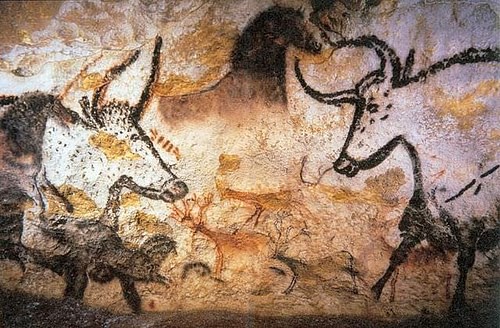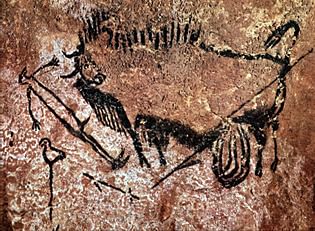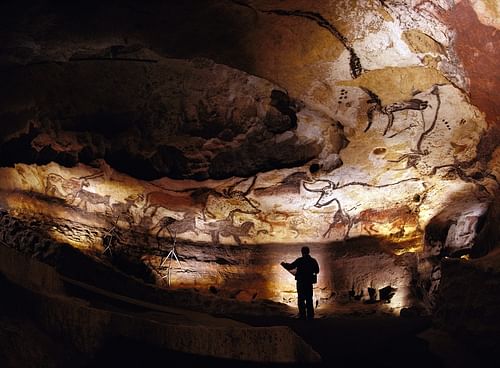Art Is an Endangered Species a History of Western Art Paleolithic Free
Lascaux Cavern is a Palaeolithic cave situated in southwestern France, near the hamlet of Montignac in the Dordogne region, which houses some of the about famous examples of prehistoric cave paintings. Close to 600 paintings – by and large of animals - dot the interior walls of the cavern in impressive compositions. Horses are the most numerous, but deer, aurochs, ibex, bison, and even some felines can besides exist institute. Besides these paintings, which represent most of the major images, there are likewise effectually 1400 engravings of a similar order. The art, dated to c. 17,000 – c. fifteen,000 BCE, falls within the Upper Palaeolithic menses and was created by the conspicuously skilled easily of humans living in the surface area at that fourth dimension. The region seems to exist a hotspot; many beautifully decorated caves take been discovered there. The exact pregnant of the paintings at Lascaux or any of the other sites is still subject area to give-and-take, but the prevailing view attaches a ritualistic or fifty-fifty spiritual component to them, hinting at the sophistication of their creators. Lascaux was added to the UNESCO World Heritage Sites list in 1979, forth with other prehistoric sites in its proximity.
The discovery
On 12 September 1940 CE four boys examined the fox pigsty downwards which their dog had fallen on the hill of Lascaux. Afterwards widening the entrance, Marcel Ravidat was the first one to slide all the manner to the bottom, his three friends post-obit later him. Later on constructing a makeshift lamp to light their way, they plant a wider diversity of animals than expected; in the Axial Gallery they first encountered the depictions on the walls. The following day they returned, improve prepared this fourth dimension, and explored deeper parts of the cave. The boys, in awe of what they had found, told their teacher, after which the process towards excavating the cave was set in movement. Past 1948 CE the cavern was ready to exist opened to the public.
Occupation past humans
Around the time Lascaux cave was decorated (c. 17,000 – c. 15,000 BCE), anatomically modern humans (human sapiens) had been well at domicile in Europe for a good while already, since at to the lowest degree 40,000 BCE. Post-obit the archaeological record, they seem to have been abundantly present in the region between southeastern France and the Cantabrian Mountains in the north of Spain, which includes Lascaux. The cave itself shows only temporary occupation, probably linked to activities related to creating the fine art. However, it is possible that the commencement couple of metres of the entrance entrance hall of the cave – the space the daylight could nevertheless reach - might have been inhabited.
The art at Lascaux was both painted on & engraved into the uneven walls of the cave, the artists working with the edges & curves of the walls to enhance their compositions.
From the finds originating from the cave, we know that the deeper parts of the cave were lit by sandstone lamps that used animal fat as fuel, equally well as by fireplaces. Hither, the artists worked in what must have been smoky weather condition, using minerals every bit pigments for their images. Reds, yellows, and blacks are the predominant colours. Blood-red was provided past hematite, either raw or as establish inside red clay and ochre; yellowish by iron oxyhydroxides; and blackness either past charcoal or manganese oxides. The pigments could be prepared by grinding, mixing, or heating, after which they were transferred onto the cave walls. Painting techniques include drawing with fingers or charcoal, applying pigment with 'brushes' made of hair or moss, and bravado the pigment on a stencil or directly onto the wall with, for instance, a hollow bone.
The catch is that at that place are no known deposits of the specific manganese oxides found at Lascaux anywhere in the expanse surrounding the cave. The closest known source is some 250 kilometres away, in the fundamental Pyrenees, which might point to a trade or supply route. It was not uncommon for humans living effectually that fourth dimension to source their materials a scrap further afield, tens of kilometres away, simply the altitude in question here may indicate that the Lascaux artists put in a superb corporeality of try.

Cavern Painting in Lascaux
Likewise the paintings, many tools were found at Lascaux. Amid these are many flint tools, some of which brandish signs of existence used specifically for carving engravings into the walls. Os tools were besides present. The pigments used at Lascaux contain traces of reindeer antler, most probable introduced either because antler was carved correct next to the pigments or because it was used to mix the pigments into water. The remains of shellfish shells, some of them pierced, tie in well with other evidence of personal adornment establish among humans living in Europe during the Upper Palaeolithic.
The art
The art at Lascaux was both painted on and engraved into the uneven walls of the cave, the artists working with the edges and curves of the walls to enhance their compositions. The resulting impressive displays depict mainly animals, simply too a significant amount of abstruse symbols, and even a homo. Of the animals, horses dominate the imagery, followed by deer and aurochs, and and then ibex and bison. A few carnivores, such as lions and bears, are also present. The archaeological record of the area shows that the depicted animals reflect the fauna that was known to these Palaeolithic humans.
The entrance of the cave leads abroad from the daylight and direct into the primary chamber of the cave, the Hall of the Bulls. Aptly named, this infinite contains mostly aurochs, a at present extinct type of large cattle. In a round trip the light fantastic, 4 large bulls tower above fleeing horses and deer, the relief of the walls serving to emphasise certain parts of the paintings. The animals are shown in side-view, but with their horns turned, giving the paintings a liveliness indicative of keen skill. And then far, these animals are easily identifiable, but others are less lucent. Meet, for example, the seemingly pregnant horse with what looks similar one horn on its head. Some other mysterious figure is depicted with panther peel, a deer's tail, a bison's hump, two horns, and a male member. Artistic minds have suggested it may be a sorcerer or wizard, just what it really represents is hard to determine.

Wounded Bull, Man & Bird, Lascaux Cave
Beyond the Hall of the Bulls lies the Axial Gallery, a dead-end passage, but a spectacular one at that. Information technology has been dubbed the 'Sistine Chapel of Prehistory,' as its ceiling is dwelling house to several centre-catching compositions. Ruby aurochs stand with their heads forming a circle, while the main figures of the Gallery stand up opposite ane some other: a mighty blackness bull on one side, a female aurochs on the other, seemingly jumping onto some sort of lattice that has been fatigued underneath her hooves. There are horses in many shapes, including one known as the 'Chinese horse,' with its hooves depicted slightly to the dorsum, demonstrating a apply of perspective far ahead of its fourth dimension. Towards the back of the passage, a horse gallops with its mane blowing in the wind while its companion falls over with legs in the air.
A second exit from the Hall of the Bulls leads to the Passage, which houses mostly engravings but also some paintings of a big variety of animals. In the Nave, post-obit the Passage, a large blackness bull as well as two bisons stand out because of their wild power, seemingly fleeing. Opposite, a freeze shows five deer who appear to exist swimming. After the Nave, the Chamber of Felines throws some predators into the mix, with engravings of lions dominating the room. In another branch of the cave, the room known equally the Shaft adds some more material for discussion. Here, besides the wounded bison with its intestines sprawling out from its gut, are a woolly rhinoceros, a bird on what might exist a stick, and a naked man with an erect member. This image clearly tells a story, although information technology is hard to be certain exactly what that story might be.

Lascaux Ii Cave Today
The cave today
The original cavern was closed to the public in 1963 CE later on it became clear that the many visitors acquired, among others, the growth of algae on the cave walls, dealing irreparable damage to the paintings. Despite the closure, fungi have spread within the cave, and efforts to control these issues and protect the art are ongoing. Those looking for an alternative feel can visit Lascaux Two, a replica of the Great Hall of the Bulls and the Painted Gallery sections, which was opened in 1983 CE and is located at a mere 200 metres from the original cave.
This article has been reviewed for accuracy, reliability and adherence to bookish standards prior to publication.
Source: https://www.worldhistory.org/Lascaux_Cave/
0 Response to "Art Is an Endangered Species a History of Western Art Paleolithic Free"
Post a Comment